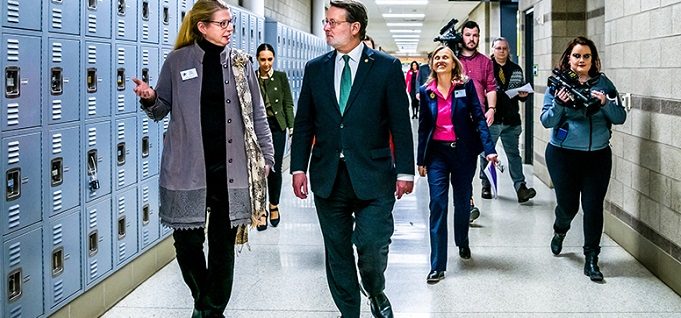Developing closer partnerships with business, industry
By Jim Paterson
November 9, 2022
Cathy Wilhm’s schedule was jammed, but she wasn’t complaining.
“We are here to educate and train students for the workforce, and we can’t do that really well without getting good information from the people who will employ them,” she says. “So that is our focus, and we take any opportunity we can get.”
Her schedule is filled by meetings with and visits by employers to fine tune the broad objectives and granular coursework for the students in the bustling technical career division at Lansing Community College, where she is the division’s dean.
There are the representatives from a $2.5 billion General Motors battery plant being constructed nearby that will employ some 1,500 workers, many of whom, Wilhm believes, could come from her division’s 21 academic programs as they flex to meet the plant’s needs.
Another visiting company representative recently came to look for potential workers for one type of manufacturing skill, but then found others with quality-control training – making tiny measurements of parts that must be sized precisely. They could be even more valuable, he found, especially if they learned some of his specific needs – making the visit doubly valuable.
Wilhm also met with officials from the company that makes 60% of the robots used in manufacturing, who offered tips on improving the training. She talked with representatives of a boat-making company that provided her with a $30,000 pontoon so her faculty and students in welding could analyze the metal work and meet the company’s needs. She also hosted a major West Coast global employer that visited the facility to meet with students and faculty in the school’s aviation and advanced manufacturing programs.
There also were company representatives who came through to look for prospective workers but could not yet discuss its specific plans or needs. Wilhm said she welcomes such visits and will certainly be in touch later as their expansion became widely known.
Then there was a regional manufacturing council meeting where new information about employer plans came to light and more contacts were made.
Getting input
In these meetings, tours and phone calls, Wilhm is touching on the variety of ways community colleges now are gaining reliable, specific, employer information beyond the quarterly or monthly workforce development meetings that often offer important but big-picture information about workforce trends.
Community colleges often get company representatives into their facilities to see what they offer and get feedback, connecting their own experts and faculty with the people who will directly supervise the workers and who know the skills needed. They talk to firms that make equipment used on the job and gather good data from key sources to help decide on the direction of programs, their enrollment levels and the courses and course content they will offer.
Through all of this, community colleges must be creative and flexible, and may have to shift attitudes that employers sometimes have about higher education, says Ian Roark, vice chancellor of workforce development and innovation at Pima Community College in Tucson.
“It has become a cliché among some of them to suggest that they are forced to hire people who can’t even read a tape measure – then [they] want to know how we are going to solve that problem,” he says. “We have to understand the workforce challenges, but also tell our story.”
Starting from scratch
While Lansing is adapting and promoting its existing programs, South Louisiana Community College (SLCC) this fall is initiating a new major based on community and employer needs and fueled by public funds.
In the state, some 20% of residents don’t have broadband, one of the worst levels in the country. One parish in the area served by SLCC has the worst broadband coverage in the nation, says Charlotte Leleux, director of transportation, distribution and logistics at the college and a member of its workforce and economic team.
She notes that a need for technicians in this field – highlighted further by the state’s effort to fill the gap and federal infrastructure funds specifically earmarked for the purpose – was the impetus for designing a new fiber optic technician program, which has garnered interest from two dozen businesses.
Consulting with the head of a company that provides equipment for broadband, LeLeux got input from two dozen companies about their fundamental needs before designing the 20-week, 700-hour course. It offers nine credentials that cover material ranging from pole-climbing techniques and construction methods, to guidelines for handling fiber cable from the companies who manufacture it and use it most.
She notes that the program is broad enough that students could take a range of starting positions and have an overview of the technology that would be helpful as they advance.
“We started by asking a lot of questions about who we should talk to and what we needed to do,” she says. “We wanted their input, but we also made it clear that they were equally responsible for the program and that the college wasn’t going to do all the work and provide all the support financially. We wanted them to be true partners.”
There’s more to the story! Read the full article in CC Daily.



